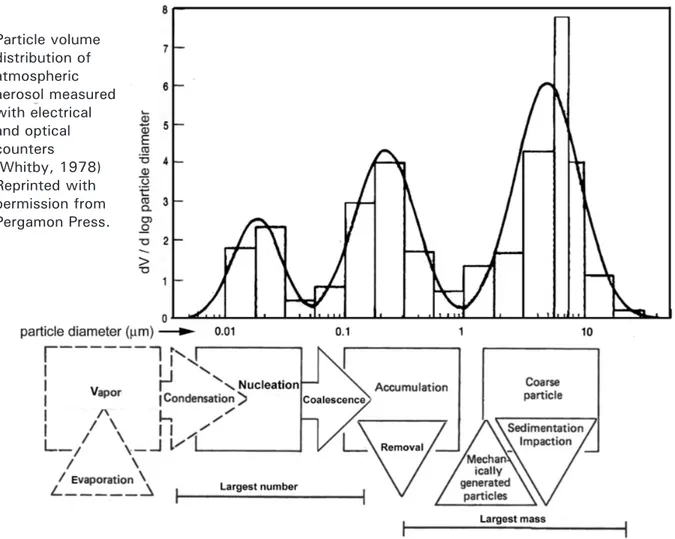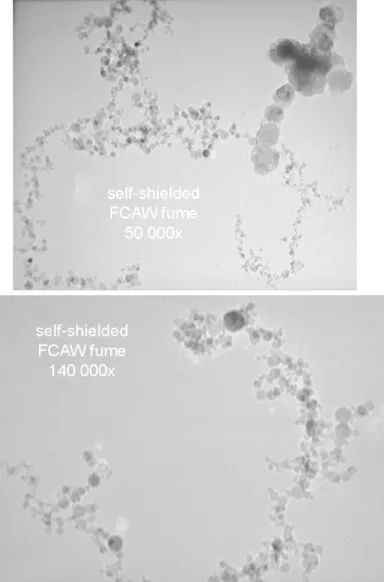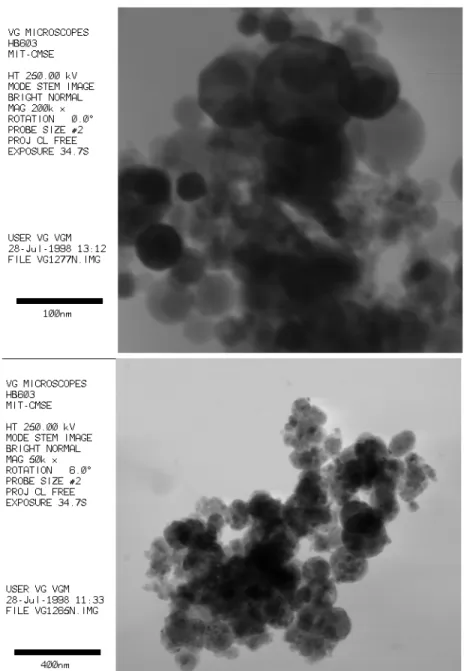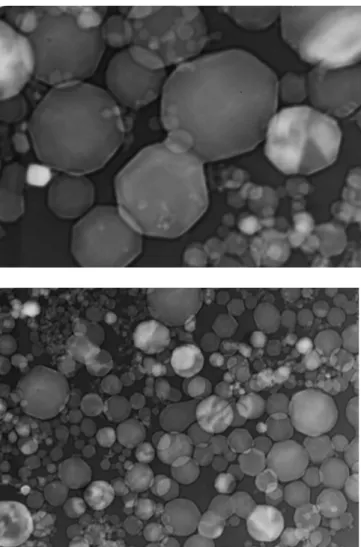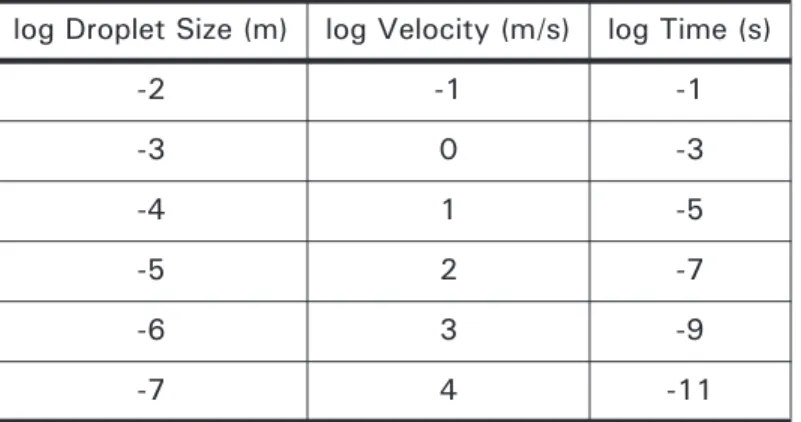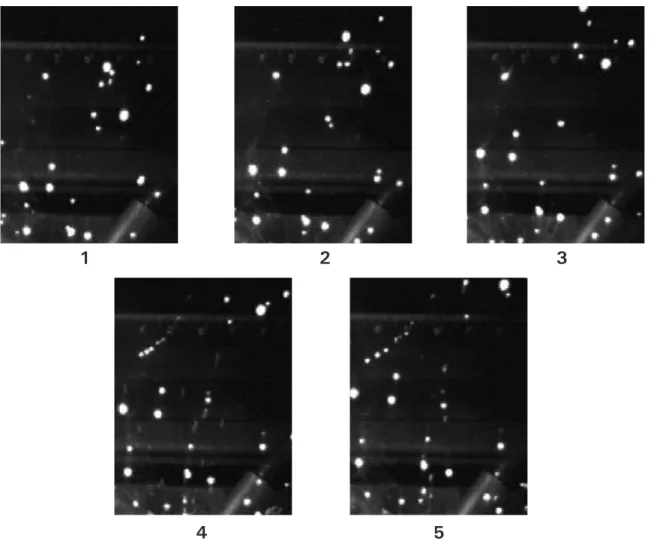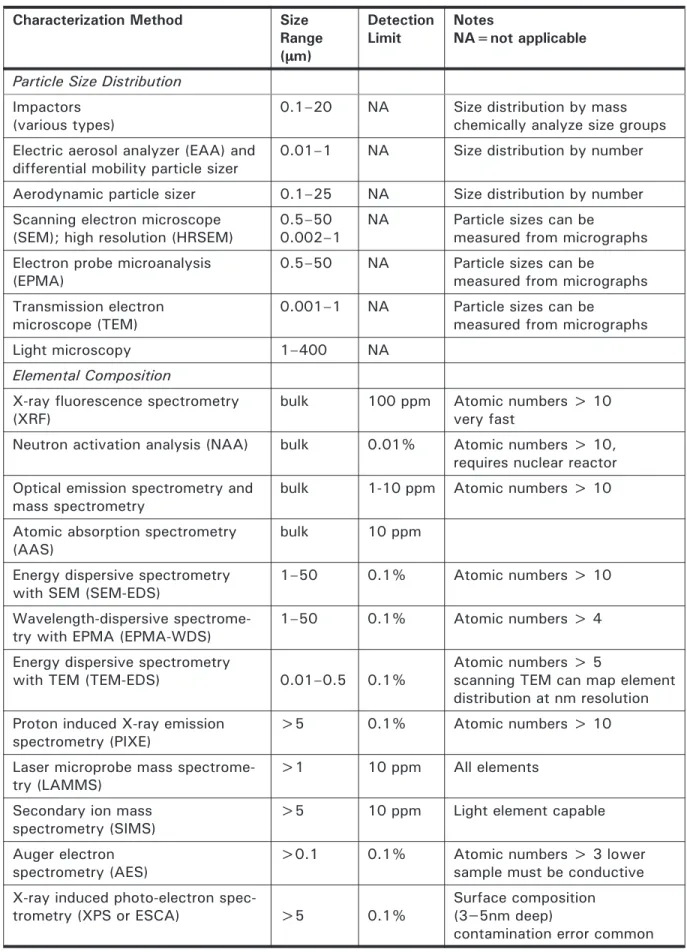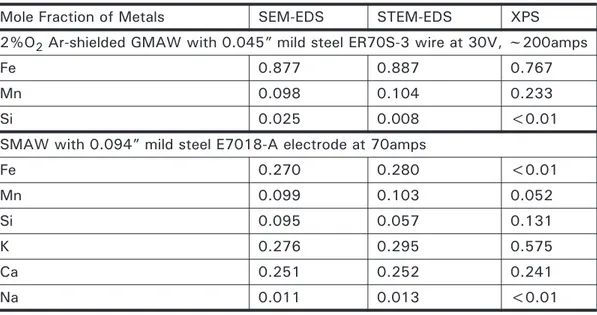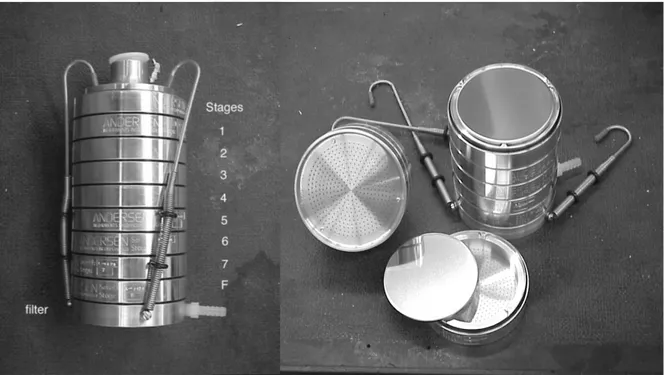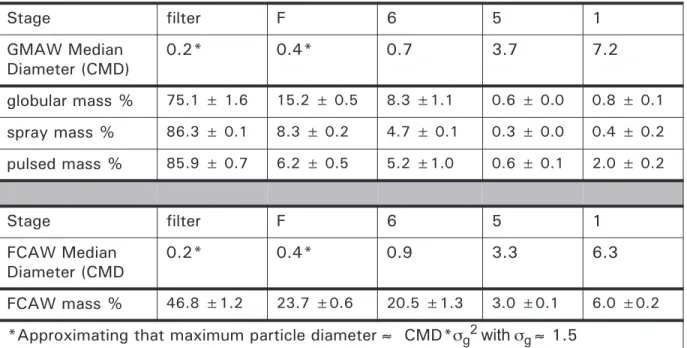Chemistry of Airborne Particles
from Metallurgical Processing
by
Neil Travis Jenkins
S. B. Materials Science and Engineering Massachusetts Institute of Technology, 1997
Submitted to the Department of Materials Science and Engineering in partial fulfillment of the requirements for the degree of
Doctor of Philosophy at the
MASSACHUSETTS INSTITUTE OF TECHNOLOGY September, 2003
© Massachusetts Institute of Technology, 2003. All Rights Reserved.
Author ...
Department of Materials Science and Engineering August 22, 2003
Certified by ...
Thomas W. Eagar Thomas Lord Professor of Materials Engineering and Materials Systems Department of Materials Science and Engineering Thesis Supervisor
Accepted by ...
Harry L. Tuller Professor of Ceramics and Electronic Materials Chair, Graduate Committee Department of Materials Science and Engineering
Chemistry of Airborne Particles from Metallurgical Processing
by
Neil Travis Jenkins
Submitted to the Department of Materials Science and Engineering on August 22, 2003, in partial fulfillment of the requirements for the degree of
Doctor of Philosophy in Metallurgy
Abstract
Airborne particles fall into one of three size ranges.
The nucleation range consists of nanoparticles created from vapor atom collisions. The decisive parameter for particle size and composition is the supercooling of the vapor. The accumulation range, which comprises particles less than 2 micrometers, consists of particles formed from the collision of smaller primary particles from the nucleation range. The composition of agglomerates and coalesced particles is the same as the bulk vapor composition.
Coarse particles, the composition of which is determined by a liquid precursor, are greater than 1 micrometer and solidify from droplets whose sizes are controlled by surface, vis-cous, and inertial forces.
The relationship between size and composition of airborne particles could be seen in weld-ing fume, a typical metallurgical aerosol.
This analysis was performed with a cascade impactor and energy dispersive spectrometry with both scanning electron microscopy (SEM-EDS) and scanning transmission electron microscopy (STEM-EDS). Other methods for properly characterizing particles were dis-cussed.
In the analysis, less than 10% of the mass of fume particles for various types of gas metal arc welding (GMAW) were coarse, while one-third of flux cored arc welding (FCAW) fume particles were coarse. Coarse particles had a composition closer to that of the welding elec-trode than did fine particles.
Primary particles were not homogeneous. Particles larger than the mean free path of the carrier gas had the same composition as that of the vapor, but for particles 20 to 60 nanometers, smaller particles were more enriched in volatile metals than larger particles were. This was explained by the cooling path along the bubble point line of a binary phase diagram.
Particles were not necessarily homogenous internally. Because nanoparticles homogenize quickly, they may form in a metastable state, but will not remain in that state. In this analy-sis, the presence of multiple stable immiscible phases explains this internal heterogeneity. The knowledge contained herein is important for industries that depend on the properties of nanoparticles, and for manufacturing, where industrial hygiene is important because of respirable particle by-products, such as high-energy-density metallurgical processing.
Thesis Supervisor: Dr. Thomas W. Eagar, ScD. P.E.
Table of Contents
Table of Contents 5 List of Figures 7 List of Tables 13 List of Symbols 15 Acknowledgements 17 Chapter 1: Introduction 21Chapter 2: Previous Research on Welding Fume 29
2.1 General Welding Fume Information 29
2.2 Effect of Welding Fume Exposure on Health 31
2.3 Methods for Formation Rate Measurement 32
2.4 Formation Rate Measurements 33
2.5 Formation Theories and Models 35
2.6 Fume Chemistry Theories and Models 38
2.7 Welding Society Reports & Multiple Technique Characterization 39
2.8 Hexavalent Chromium Measurements 40
2.9 Surface Characterization 42
2.10 Phase Composition and Crystallographic Structure 43
2.11 Other Characterization 44
2.12 Particle Size Distribution 44
2.13 Particle Size Distribution and Inhalation Toxicology 45
2.14 Relationship between Chemistry and Particle Size 45
2.15 Masters Theses 46
2.16 Doctoral Dissertations 47
Chapter 3: Airborne Particle Size 49
3.1 Nucleation Range 50
3.2 Accumulation Range 54
3.3 Coarse Particle Range 58
3.4 Conclusion and Examples 67
Chapter 4: Airborne Particle Characterization 79
4.1 Particle Collection 79
Chapter 5: Chemical Composition and Particle Size 91
5.1 Coarse Particles 93
5.1.1 Metal Distribution Determined with Cascade Impactor 93
5.1.2 Discussion 108
5.2 Fine Particles 113
5.2.1 Relationship between Composition and Primary Particle Size 113
5.2.2 Internal Heterogeneity 138
5.2.3 Vaporization 153
Chapter 6: Conclusion 165
Appendix A: Fume Formation from Spatter Combustion 173
Appendix B: Surfactant Aided Dispersion of Nanoparticular Suspension of Welding
Fume 181
List of Figures
1.1 Deposition of particles in human respiratory tract (2150 ml tidal volume) (International Commis-sion on Radiological Protection, 1966).
21
1.2 Size scale of particles in human lung (Lighty, et al., 2000).
22
3.1 Size distribution common to airborne particles
49
3.2 Critical diameter predicted by classical nucleation theory for common metals. Data from Brandes, 1983. Last point for each metal is at 99% of boiling temperature.
52
3.3 Transmission electron micrograph of aerosol particles from mild steel FCAW fume
53
3.4 Particle size change due to agglomeration with respect to time for a monodisperse aerosol of constant aerosol-to-carrier-gas fraction and initial number concentration of particles.
55
3.5 Transmission electron microscopy of fume from mild steel gas metal arc welding (top) and shielded metal arc welding (bottom).
57
3.6 Dependence of primary particle size on cooling rate
57
3.7 (Top) Mild steel GMAW fume (6.1 mg) of dispersed with 2 ml of acetylacetone + 0.004 g of iodine. Magnification = 270 000 X.
58
3.8 (Bottom) Mild steel GMAW fume (6 mg) dispersed with 2.5 ml ethanol + 10-3 mol of lauric acid. Magnification = 140 000 X.
58
3.9 Calculated change in temperature (K) of iron welding spatter droplets of various diameters (d) with time (s)
60
3.10 Velocity required to form droplets of a certain size from average liquid metal
61
3.11 Particle distribution found in laser ablation (Riehemann, 1998)
62
3.12 How spatter can form from liquids when gas bubbles escape (Richardson, 1974)
63
3.13 Sequential frames (interval = 6 ms) from high-speed videography of CO2-shielded mild steel GMAW
64
3.14 Series of frames spaced 0.5 milliseconds from high speed video of electrode laser shadow from gas metal arc welding with 1.6 mm electrode, 2%O2-Ar, 240 amperes.
65
3.15 Series of frames spaced 0.5 milliseconds from high speed video of electrode laser shadow from gas metal arc welding with 1.6 mm electrode, 2%O2-Ar.
66
3.16 (Top Left) Weld fume mass distribution (inertial separation) (Heile & Hill, 1975)
3.18 (Top Right) SMAW fume mass distribution from 0.3 m above weld (low pressure cascade impactor; smallest cutoff=150 nm) (Berner & Berner, 1982)
69
3.19 (Low Left) SMAW, GMAW fume mass distribution (cascade impactor; smallest cutoff = 80 nm) (Eichhorn & Oldenburg, 1986)
69
3.20 (Low Right) Mild, stainless steel SMAW, GMAW fume mass distribution (micro-orifice uniform deposit [cascade] impactor; cutoff = 71 nm) (Hewett, 1995).
69
3.21 (Top Left) Size distribution of 20%CO2-Ar shielded GMAW fume from ER70S-6 wire of various diameters (laser particle counter, 0.1–7.5 micrometer range) (Jin, 1994)
70
3.22 (Bottom Left) Size distribution of well-mixed & cooled GMAW fume created with 31 different voltage and current settings (pulsed and straight) with E70S-3 wire and 8%CO2-Ar shield (electrical aerosol analyzer, 0.003 –1 micrometer range) (Ren, 1997)
70
3.23 (Bottom Right) Size distribution of welding fume when sampled at various times (seconds) after formation (electrical aerosol analyzer, 0.003 –1 micrometer range) (Ren, 1997)
70
3.24 Effects on fume size distribution (clockwise from upper left) a. time after welding before sam-pling, b. distance from weld to sampler, c. GMAW vs. FCAW (self - shielded E71T- 11) d. shield gas (Zimmer, 2001)
71
3.25 (Left) Size distribution of mild steel GMAW fume (Aerosizer particle size analyzer); total no. concentration for both shielding gases was ~25 cm-3 (Zimmer, 2002)
72
3.26 (Right) Combined particle size distribution (SMPS+Aerosizer) of mild steel GMAW fume (Zim-mer, 2002)
72
3.27 Upper (Left) Size distribution of primary particles in Inconel 6251 welding fume agglomerates (automated image analysis of transmission electron micrographs) (Farrants, et al., 1989)
73
3.28 (Upper Right) Size distribution of SMAW & GMAW fume (extrapolated diameters (0.1–2.8 micrometer) of > 1000 particles per fume, from scanning electron micrographs) (Fasiska, et al., 1983)
73
3.29 (Lower Right) Size distribution of steel welding fume collected on filters (scanning electron microscopy) (Gustafsson, et al., 1986)
73
4.1 Welding fume collection chamber with welded pipe.
80
4.2 Photograph of mild steel welding fume, from SMAW (left) and GMAW (right).
80
4.3 (Top) X-ray diffraction spectrum for mild steel GMAW fume
89
4.4 (Bottom) X-ray diffraction spectrum for mild steel SMAW fume
89
5.1 Andersen Cascade Impactor. Only stages 1, 5, 6 and F were used, along with the bottom filter.
95
5.2 Scanning electron microscopy of stainless steel GMAW welding fume particles separated by a Thermo Andersen cascade impactor, using 4 stages and a filter. Particles transferred from stages numbered 1, 5 and 6, are shown here from top to bottom at 200x, 500x, and 1000x respectively.
5.3 Scanning electron microscopy of stainless steel FCAW welding fume particles separated by a Thermo Andersen cascade impactor, using 4 stages and a filter. Particles transferred from stages numbered 1, 5 and 6, are shown here from top to bottom at 500x, 500x, and 1000x respectively.
97
5.4 Scanning electron microscopy of stainless steel welding fume particles separated by a Thermo Andersen cascade impactor, using 4 stages and a filter. Particles transferred from stage F and from filter shown here.
98
5.5 Scanning electron microscopy of iron particles separated by a Thermo Andersen cascade impac-tor, using 4 stages and a filter. Particles transferred from stages numbered 1, 5 and 6, are shown here from top to bottom at 500x, 1000x and 2000x respectively.
99
5.6 Frequency distribution of welding fume mass found with multistage impactor with respect to count median diameter of fume found on each stage. Mass fraction is normalized by dividing by the particle range of each stage, from CMD / sg to CMD*sg
101
5.7 Metals content of stainless steel GMAW (spray conditions) fume collected in a multistage cas-cade impactor, as determined by energy dispersive spectrometry in a scanning electron microscope.
102
5.8 (Left) Mole fraction of metals in stainless steel FCAW fume collected in a multistage cascade impactor, as determined by energy dispersive spectrometry in a scanning electron microscope.
104
5.9 (Right) Metals in stainless steel FCAW welding fume, matched by chemical similarity and com-parative volatility, by molar fraction
104
5.10 Elemental composition of SMAW fume with respect to aerodynamic diameter determined with low pressure cascade impactor (smallest cutoff at 150 nm) and energy dispersive spectrometry (Berner & Berner, 1982)
105
5.11 (Left) Metal content (SEM-EDS) of stainless steel stainless steel SMAW fume separated with cascade impactor by aerodynamic diameter (Narayana, et al., 1995)
106
5.12 (Right) Metals content (AAS) of high manganese hardfacing SMAW fume separated with cas-cade impactor by aerodynamic diameter (Tandon, et al., 1984)
106
5.13 Metals fraction of SMAW and GMAW fume with respect to aerodynamic diameter, determined with micro-orifice uniform deposit [cascade] impactor (MOUDI) and mass spectrometry (Hewett, 1995)
107
5.14 Distribution of CrVI in stainless steel (ER347) GMAW fume, six samples (Kura, 1998)
108
5.15 Transmission electron micrograph and elemental maps from energy dispersive spectrometry of mild steel gas metal arc welding fume.
115
5.16 Transmission electron micrograph and cation maps from energy dispersive spectrometry of mild steel shielded metal arc welding fume. Composite map in upper right.
116
5.17 Transmission electron micrograph and cation maps from energy dispersive spectrometry of mild steel FCAW fume. Composite map in upper right.
117
5.18 Transmission electron micrograph and cation maps from energy dispersive spectrometry of mild steel FCAW fume. Composite map in upper right.
5.19 Transmission electron micrograph and cation maps from energy dispersive spectrometry of mild steel FCAW fume. Composite map in upper right.
119
5.20 Transmission electron micrograph and oxygen concentration map from energy dispersive spec-trometry of mild steel FCAW fume composed of oxides and fluorides. Same agglomerates as in Fig-ure 5.17, FigFig-ure 5.18, and FigFig-ure 5.19.
120
5.21 Transmission electron micrograph (50 000x) of mild steel gas metal arc welding fume
121
5.22 Mole fraction of manganese with respect to iron in mild steel gas metal arc welding fume as a function of particle size, determined with energy dispersive spectrometry / transmission electron microscopy (representative micrograph included).
122
5.23 Atomic fraction of metals content in stainless steel gas metal arc welding fume as a function of particle size, as determined with energy dispersive spectrometry / transmission electron micros-copy (representative micrographs included).
123
5.24 Metals content in mild steel flux cored arc welding fume as a function of particle size, as deter-mined with energy dispersive spectrometry / transmission electron microscopy (representative micro-graphs included).
124
5.25 Atomic fraction of metals content in stainless steel flux cored arc welding fume as a function of particle size, as determined with energy dispersive spectrometry / transmission electron micros-copy (representative micrographs included).
125
5.26 Iron-manganese phase diagram at 0.3 atmosphere pressure (Sundman, 1991).
128
5.27 Nucleation dominated formation model for welding fume particles. Phase diagram of iron-man-ganese system calculated at 0.3 atmosphere pressure.
131
5.28 Growth dominated formation model for welding fume particles. Phase diagram of iron-manga-nese system calculated at 0.3 atmosphere pressure.
132
5.29 Composition of condensation particle before homogenization.
133
5.30 Mole fraction of metals content, grouped by boiling point, in stainless steel gas metal arc weld-ing fume as a function of particle size, as determined with energy dispersive spectrometry / transmis-sion electron microscopy.
135
5.31 Large mild steel flux cored arc welding fume particle.
140
5.32 Transformation of data from spot elemental analysis of particle with transmission electron microscopy. Electron beam interaction with particle is approximated such that only the cylindrical cross-section at each spot is considered.
140
5.33 (Left) Composition profile of 175 nm stainless steel gas metal arc welding fume particle (scan-ning transmission electron microscopy / energy dispersive spectrometry)
142
5.34 (Right) Composition profile of 500 nm mild steel flux-cored arc welding fume particle (scanning transmission electron microscopy / energy dispersive spectrometry)
142
5.35 (Left) Composition profile of 1000 nm stainless steel flux-cored arc welding fume particle (scanning transmission electron microscopy / energy dispersive spectrometry)
5.36 (Right) Composition profile of 460 nm stainless steel flux-cored arc welding fume particle (scanning transmission electron microscopy / energy dispersive spectrometry)
143
5.37 Heat transfer through GMAW electrodes is controlled by electrode droplet size. Shadowgraphs of are 2%O2-Ar shielded GMAW mild steel electrode. See Mendez, et al., 2000 and Jones et al., 1998.
155
5.38 (Left) Effect of oxidation potential of shielding gas on bulk composition (ICPMS) of fume formed from single-pulse gas metal arc welding without droplet detachment (100 amps for 500 ms)
156
5.39 (Right) Fume composition versus oxidation potential of shielding gas in argon-shielded GMAW with 1.2 mm E308 stainless electrode (Sreekanthan, 1997).
156
5.40 (Left) Electrode droplet period (which is directly proportional to droplet size) versus shielding gas composition in GMAW with1.6 mm mild steel electrode for various currents. Data from Rhee (1992).
157
5.41 (Right) Fume formation rate dependence on shielding gas in GMAW with1.2 mm mild steel electrodes using a current of 250 amperes. Data from Heile and Hill (1975) and Hilton and Plumridge (1991).
157
5.42 Fume generation rate and the nickel to manganese ratio both vary in the same way with cur-rent for argon shielded GMAW with two 1.2 mm electrodes: AWS ER307 Si (left) and ER308L Si (right). This indicates that the controlling variable is the same: electrode droplet surface temperature. Data adapted from Eichhorn and Oldenburg, 1986.
158
5.43 Iron-manganese vapor-liquid phase diagram at 0.3 atmosphere, adapted to show the effect of superheat on vapor composition
159
6.1 A diagram of the different types of forces and the materials properties that directly control the nature of airborne particles in a specific size range.
167
6.2 (Left) Metals content of stainless steel GMAW fume, as determined by energy dispersive spec-trometry in electron microscopes.
171
6.3 (Right) Metal content (EDS) in stainless steel FCAW fume, as determined by energy dispersive spectrometry in electron microscopes.
171
A.1 Frame (duration = 1 ms) from high-speed videography of CO2 - shielded mild steel GMAW
173
A.2 Calculated change in temperature (K) of spatter droplets of various diameters (d) with time (s).
176
A.3 Arc melter
178
B.1 Ultrasonic probe.
182
B.2 (Top) Transmission electron micrograph 27 000x. 7.5 mg mild steel GMAW fume in 2.5 ml eth-anol.
183
B.3 (Bottom) Transmission electron micrograph 27 000x. 7.5 mg mild steel GMAW fume in 2.5 ml ethanol + 10-3 mol lauric acid.
B.4 (Top) Transmission electron micrograph 50 000x. 7.5 mg mild steel GMAW fume in 2.5 ml eth-anol.
184
B.5 (Bottom) Transmission electron micrograph 50 000x. 7.5 mg mild steel GMAW fume in 2.5 ml ethanol+ 10-3 mol lauric acid.
184
B.6 (Top) Transmission electron micrograph 41 000x. 5 mg of mild steel GMAW fume in 2.5 ml eth-anol.
185
B.7 (Bottom) Transmission electron micrograph 50 000x. 7.5 mg of mild steel GMAW fume in 2.5 ml ethanol+ 10-5 mol lauric acid.
185
B.8 (Top) Transmission electron micrograph 10 000x. 7.5 mg of mild steel GMAW fume in 2.5 ml ethanol.
186
B.9 (Bottom) Transmission electron micrograph 10 000x. 6.0 mg mild steel GMAW fume in 2.0 ml ethanol + 10-7 mol lauric acid.
List of Tables
3.1 Properties of liquid metals extrapolated to boiling temperature (Brandes, 1983)
51
3.2 Estimated time for a droplet to break up into smaller droplets
60
3.3 Surface tension and density at melting point for various metals (Brandes, 1983)
61
4.1 Parameters for Welding Fume Generation
81
4.2 Characterization Methods for Particle Size and Chemistry
82
4.3 Composition of GMAW and FCAW wire used to create welding fume (emission spectrometry and inert gas fusion)
86
4.4 Analysis of bulk welding fume with techniques based on atomic numbers.
86
4.5 Analysis of bulk welding fume with techniques based on atomic masses.
87
4.6 X-ray diffraction of mild steel welding fume
88
5.1 Description of welding processes studied.
94
5.2 Particle distribution by count median diameter (CMD) and geometric standard deviation (sg) col-lected by each impaction plate with 28.3 L/min flow rate
100
5.3 Particle distribution, by percentage (%) of total fume mass collected
100
5.4 Metals content of stainless steel GMAW (spray conditions) fume collected in a multistage cas-cade impactor, as determined by energy dispersive spectrometry in a scanning electron microscope.
102
5.5 Metals content of stainless steel FCAW fume collected in a multistage cascade impactor, as determined by energy dispersive spectrometry in a scanning electron microscope.
103
5.6 CrVI distribution in stainless steel GMAW fume
108
5.7 Description of welding processes studied with scanning transmission electron microscopy -energy dispersive spectrometry.
121
5.8 Atomic fraction of metals content in mild steel gas metal arc welding fume per size group (30 particles each), determined with energy dispersive spectrometry / transmission electron microscopy. Manganese mole fraction of the electrode was 0.012.
122
5.9 Atomic fraction of metals content in stainless steel gas metal arc welding fume per size group (30 particles each), determined with energy dispersive spectrometry / transmission electron micros-copy. Bulk fume by SEM-EDS; Electrode by ICPMS.
5.10 (Left) Metals content in mild steel flux cored arc welding fume as a function of particle size (energy dispersive spectrometry / transmission electron microscopy)
124
5.11 (Right) Mild steel flux-cored electrode (E71T-GS) composition; metals only
124
5.12 Atomic fraction of metals content in stainless steel flux cored arc welding fume per size group (30 particles each), as determined with energy dispersive spectrometry / transmission electron microscopy. Bulk fume composition by SEM-EDS; Electrode composition by ICPMS.
126
5.13 Approximate values for particles of similar composition to those found in Figure 5.22 assuming vapor enrichment
134
5.14 Composition measurements (scanning transmission electron microscopy / energy dispersive spectrometry) along a diameter of a 150 nanometer stainless steel gas metal arc welding fume parti-cle
145
5.15 Composition measurements (scanning transmission electron microscopy / energy dispersive spectrometry) along a diameter of a 120 nanometer mild steel flux cored arc welding fume particle
146
5.16 Composition measurements (scanning transmission electron microscopy / energy dispersive spectrometry) along a diameter of a 140 nanometer mild steel flux cored arc welding fume particle.
147
5.17 Composition measurements (scanning transmission electron microscopy / energy dispersive spectrometry) along a diameter of a 500 nanometer mild steel flux cored arc welding fume particle
148
5.18 Composition measurements (STEM-EDS) along a diameter of a 1000 nm stainless steel FCAW fume particle
149
5.19 Composition measurements (STEM-EDS) along a diameter of a 460 nm stainless steel FCAW fume particle
150
5.20 Effect of oxidation potential of shielding gas on bulk composition of fume formed from single-pulse gas metal arc welding (100 amps for 500 ms) of E308L wire without droplet detachment, reported as molar fraction of metals only as determined by ICPMS.
List of Symbols
A area
Bi Biot number
C elemental composition
C+j elemental composition of core at point +j from center of particle
Cp heat capacity
d diameter of particle or feature
d* critical nucleus diameter
d0 initial particle diameter
D diffusion coefficient
I current
kair thermal conductivity of air
kB Boltzman constant
L heat of phase change
MA atomic weight of species A
O Ohnesorge number
P pressure
PA vapor pressure of species A,
PA,∞ vapor pressure over a flat surface of species A
q electrical charge on surface
Q heat r radius R gas constant t time T temperature Tb boiling temperature v velocity V volume W Weber number
α # neighbor particles that combine with any given primary particle
γ surface energy or surface tension
∆G free energy of phase change or reaction
∆G°reaction equilibrium free energy of reaction
ε emissivity
εo permeability of vacuum
η viscosity of the carrier gas
κ molar concentration of particles in volume of carrier gas
Ξ fissility
ρ density
σ electrical conductivity or Stefan-Boltzman number σg geometric standard deviation
Χ+j point composition at point +j from center of particle
Ω molar volume
acronyms:
ACGIH American Conference of Governmental Industrial Hygienists
CMD count median diameter
CrVI hexavalent chromium
CTWD contact tip to work distance DCEP direct current electrode positive
FCAW flux-cored arc welding
GMAW gas metal arc welding
GTAW gas tungsten arc welding
ipm inches per minute
MMD mass median diameter
OSHA Occupational Safety and Health Administration
PEL Permissible Exposure Limit
SMAW shielded metal arc welding
TLV Threshold Limit Value
TWA time-weighted-average
wfs wire feed speed
Acknowledgements
The funding for this project was provided by a grant from the U.S. Navy, Office of Naval Research. The gracious George Yoder was the contract monitor.
I would also like to thank the United States Department of Defense for granting me the National Defense Science and Engineering Graduate Fellowship.
Appreciation is expressed to Lippincott, Williams & Wilkins, the Air & Waste Man-agement Association, and Pergamon Press, and Elsevier, who have allowed me to reprint figures from publications of theirs.
Over the years, many people have given of themselves to help me in many different ways. I appreciate their assistance and support greatly.
First are my parents, LaVere H. and Rose Ellen Jenkins, who for the past few years have endured the shocked faces of their friends and associates when told that I was still in school. I love them and the rest of my family dearly.
Tom Eagar is one of a kind. He the best advisor a grad student can have, brilliant but considerate. He has expanded my horizons and given me exactly the right kind of support whenever I needed it. He is a prince among men.
I have been very lucky to work with and share lab and office space with the mem-bers of the Welding and Joining Group. They have all been splendid. I got my bach-elor’s with Chris MacDonald (the real Good Will Hunting); he’s the one who convinced me to work for Tom. Pradeep Sreekanthan was my predecessor in weld-ing fume research and was very kind to show me what I was gettweld-ing into. John Matz showed me how to navigate the Welding Lab. I have spent many hours work-ing on lab equipment with Don Galler. We have shared countless stories and argu-ments. My conversations with Jeff Nystrom always left me thinking. The Mormon boys (Burke Hunsaker, Mike Balmforth, Doug Cannon, and Chris Musso) were quite the crew. I think Chris will take over the world someday. I got to go to Rodrigo Quintero’s wedding in Mexico; that rocked. His cousin, Raymundo Arroyave is el verdad Maestro del Universo. He’s been the best labmate and colleague a guy can have. And did I mention brilliant? I will miss him enormously. Patricio Mendez is on fire. I think he will change the world if people will just listen to him. Jin Woo Park, Harold Larson and Jerilyn Hill were always very friendly and helpful. I could alway count on Jeri to help me out when I was frustrated with some sort of administrative detail. Kathleen Farrell has also been extremely helpful with departmental adminis-tratia.
My undergraduate employees were an assorted crew, but they were a pleasure to work with. They were: Robert Lin (yet another Mormon, yeesh), Jessica Tsay,
Eunice Chang, Simon Adelmann (a stylish British superachiever from University of Cambridge) and Wendy Pierce. I’m sure each of them will leave a noticeable mark on the world.
I collaborated with some folk at the Harvard School of Public Health. I would like to thank G. G. Krishna Murthy, James Antonini, Joe Brain, Nick Lawryk, and Brenda Dunn for contributing to my professional development.
The fellows from the Electron Microscopy Lab, Mike Frongillo and Tony Garrett-Reed, were very helpful with my microscopy. Special thanks goes to Lenore Rainey from the lab next door. She also studies fine particles and without recompense gave me a lot of pointers and kindly let me use her equipment.
I also thank her boss, Prof. John Vander Sande, and also Prof. Steven Tannenbaum for taking the time to be on my thesis committee. Professors Claude Lupis, Gael Ulrich, and Kwadwo Osseo-Asare were very generous to spend time with me dis-cussing thermodynamics, aerosol theory, and particle dispersion, respectively. Gordon Law was referred to me by Tom and has been a marvelous help with proof-ing and editproof-ing and by beproof-ing so upbeat and friendly. Many thanks.
Mark Spilker, Matt Wall and Ben Linder showed me that one can get a Ph.D. at MIT and still be somewhat normal. They, along with Mike Chatwin, Eddie Baik, Mark Abernathy, and Robert August, have been my best friends and great house mates. Thank-you, Roadkill Buffet and German House.
Finally, I would like to thank Ursula Zimmermann, Nipsy, David Heller, Kristine Girard, and Maria Louisa Izamis for their support. They know why.
Textbooks and Heaven only are Ideal; Solidity is an imperfect state. Within the cracked and dislocated Real Nonstoichiometric crystals dominate. Stray Atoms sully and precipitate; Strange holes, excitons, wander loose; because Of Dangling Bonds, a chemical Substrate Corrodes and catalyzes ... from “The Dance of Solids” by John Updike in Midpoint and Other Poems, Alfred A. Knopf, 1969
Chapter 1
11 1
Introduction
High-temperature metallurgical processing, like welding, can cause significant evap-oration. In gas metal arc welding (GMAW), this can be about 10% of the consum-able electrode. Vaporization is also significant in other processes like thermal spraying, combustion, casting and any laser or electron-beam manufacturing. When the vapor condenses, submicron airborne particles are formed. The composition of such particles can vary with size (Cox, et al., 1985; Dams & Zhang, 1987; Linak & Wendt, 1993; Narayana, et al., 1995).
Chemical heterogeneity with size is important for manufacturing and is critical in industrial hygiene because the respirability of airborne particles is dependent on par-ticle size, which can affect exposure to a possible toxin. Parpar-ticles smaller than 100
micrometers can be airborne, but not all airborne particles are deposited in the lungs (see Figure 1.1). Objects greater than 10 micrometers in size are trapped on the Figure 1.1 Deposition of particles in human respiratory tract (2150 ml tidal volume) (International Commission on Radiological Protection, 1966).
walls of the human airway before they reach the lungs and are carried away in the mucus, which is then transported to the digestive tract. Particles smaller than 0.1 micrometer are inhaled and deposit in the lungs (Figure 1.2). Particles or agglomer-ates between 0.1 and 1 micrometer can be exhaled, meaning that only about 30% of particles of this size eventually deposit in the lungs where they eventually dis-solve into the blood (Hewett, 1995).
Increasing numbers of industrial applications, such as powder metallurgy, electro-magnetic coatings, optical fibers, catalysts and sunscreens, incorporate submicron particles. The nanopowder market, which comprises these and other products, is projected to double between 2000 and 2005 to almost $1 billion (Rittner, 2002).
Figure 1.2 Size scale of particles in human lung (Lighty, et al., 2000). Reprinted by permission of Air & Waste Management Association.
Quite generally, particles are formed one of three ways: 1. from solids and liquids by mechanical means (e.g., grinding or liquid atomization), 2. chemically in solutions and colloids or 3. from a vapor by condensation. Particles formed mechanically under natural conditions are at least 1 micrometer in diameter (unless fabricated means with certain materials are employed, such as special mechanical attrition or electrostatic capillaries). Particles chemically formed from an aqueous solution can be of almost any reasonable size, but such solutions are not commonly used in high-temperature processes and thus this path is not considered here. Particles created by condensation are 0.001 to 1 micrometer in diameter (Kodas & Hampden-Smith, 1999). Because condensation methods are the easiest to scale up for manufactur-ing, they are the main source of such powders.
Condensed ultrafine powders used in manufacturing are created with heat sources like: resistive heating (Gleiter, 1989), exploding wires (Kotov & Samatov, 1999), ion sputtering (Gurav, et al. 1993), laser evaporation or ablation (Rieheman, 1998), thermal plasmas (Dong, et al. 1999; Balabanova, 2000), and flames (Axelbaum, et al., 1997). For a good review, see Gurva, et al., 1993.
Control of particle size has been extensively studied. For example, researchers have found that small particle size is best achieved with high cooling rates, low evapora-tion temperatures, low pressures and low molecular weight of the inert carrier gas and low metal vapor concentration (Panda & Pratsinis, 1995). However, controlling the chemistry of condensed material can be difficult; more so than controlling that of particles formed mechanically or chemically (Kodas & Hampden-Smith, 1999). The change in chemistry with particle size can be explained by principles of aerosol science and physical chemistry, as illustrated by a study of fume (particulate mate-rial that condenses from metal vapor) formed during welding. Welding fume is also of particular concern for health reasons.
There are nearly 0.5 million workers who perform welding and cutting operations full-time in the United States (Bureau of Labor Statistics, 2001) and as many as 1 million to 2 million additional workers weld intermittently. Welding is essential to the construction of modern naval vessels, among other fabrication.
Arc welding can be dangerous. Physical hazards include heat, noise and vibration, and electrical power. Radiation from the arc can cause eye and skin damage. Chem-icals in the welding environment are found in gases and respirable particles and each of these chemicals can create adverse side effects after ingestion, when delivered in the appropriate dose and chemical state.
Carbon and low alloy steels represent 90% of all metal used in the world. Welders are primarily exposed to the elements in steel: iron, manganese and silicon. Iron and its oxides are metabolized in the human body, but silicon dioxide can be a lung irri-tant and manganese and its oxides can be neurotoxins. Approximately 5% of all metal fabrication requires stainless steel, which also contains chromium and nickel.
Hexavalent chromium and nickel are of concern because they can be carcinogenic in certain circumstances (Antonini, et al., 1998).
Epidemiological studies have demonstrated that welders are more likely than the general populace to develop acute metal fume fever, acute chemical pneumonitis and chronic bronchitis. They also may have a higher risk of lung cancer, but the causes of this risk are uncertain because confounding variables such as tobacco use and asbestos exposure, have not been adequately taken into account (Sferlazza & Beckett, 1991).
The solid chemical compounds released into the environment by welding enter the human body chiefly through the inhalation of fume. Arc welding causes about 10% of the consumable welding electrode to vaporize. Most of the vapor recondenses in the weld pool, but approximately one-tenth of it (about 1% of the electrode) travels out of the high-temperature arc region and condenses into metal oxide nanoparticles that aggregate into submicron clusters (Haidar, 1999).
Primary particles of welding fume range in size from a few nanometers to a few hundred nanometers. They exist in aggregates ranging from 0.01 to 2 micrometers (Voitkevich, 1995). A small fraction of unagglomerated particles may be in the range of 1 to 100 micrometers (Deam, et al., 1997), meaning that welding fume particles have a high probability of deposition in the lung alveoli.
Welding fume is composed of complex particles, most of which consist of metal oxides and of materials from electrode coatings. Major elements found include iron, manganese, chromium, nickel, silicon, potassium, sodium, calcium, titanium, alumi-num, magnesium, fluorine, and oxygen. Chromium, nickel and manganese in their pure states are the most toxic, but they are not pure in welding fume. It is not pos-sible to analyze overall toxicity based on the individual toxicities of the respective components. While two chemicals may be nontoxic when ingested alone, they may prove fatal when ingested together, or vice versa. For example, pure manganese oxide has been shown to cause neurological damage, but it has been hypothesized that iron ingested along with manganese will block the transport of manganese across the blood-brain-barrier, thus preventing neurological harm (Aschner & Aschner, 1990). The chemical state of the element in question is important also. Manganese is the most toxic element found in carbon steel welding fume. Its toxic-ity varies with valence state: +4 is the most toxic (Voitkevich, 1995). Hexavalent chromium is carcinogenic, but trivalent chromium is not. In addition, insoluble hexavalent chromium compounds are more toxic than soluble hexavalent chromium compounds (Cohen, 1997). The total volume deposited in the lung cells and the aerosol surface are also important factors for the induced pathological reactions. Insoluble particles deposited in the lung are scavenged by alveolar macrophage cells. The ability of these cells to clear the lung is affected by the total deposited volume of the aerosols. The chemistry and conformation of the particle surface influence the interactions with the alveolar macrophages. Toxic aerosols can change cell function (mutagenity, cell damage) or encourage growth of nearby epithelium cells (Haferkamp, 1998).
In 1995, the American Conference of Governmental Industrial Hygienists (ACGIH) reduced the Threshold Limit Value (TLV) for manganese airborne particulate from 1000 µ g/m3 to 200 µ g/m3. It has also announced plans to reduce the TLV for insoluble nickel compounds from 1000 µ g/m3 to 100 µ g/m3 and to 50 µ g/m3 for soluble compounds. More importantly, the Occupational Safety and Health Adminis-tration (OSHA) has indicated that it will reduce the Permissible Exposure Limit (PEL) for hexavalent chromium (as chromates) from the present ceiling value of 100 µ g/ m3 to an eight-hour time-weighted-average (TWA) between 0.5 µ g/m3 and 5.0 µ g/ m3 (National Shipbuilding Research Program, 1996).
A Navy / Industry Task Group estimated that it would cost the U.S. Navy initially $3 to $22 million and afterwards $5 to $46 million annually to comply with the pro-posed OSHA hexavalent chromium PEL. The magnitude of the cost will naturally depend on how much the PEL is lowered (National Shipbuilding Research Program, 1996).
The OSHA and ACGIH standards are based on studies of chromium in electroplating shops (Beckett, 1996) and manganese from paint pigments and in mines. While it is known that manganese and chromium are present in welding fume, their exact chemical forms are not completely understood. They may or may not be similar to the chemistry of chromium and manganese introduced into the environment by other industrial processes. The chemical reactivity of the components of welding fume must be analyzed in order to determine whether data from other industries are applicable to welding fume. Without such information, OSHA will assume that the chemistry is the same and will produce standards that will severely restrict welding activity. By comparing an informed study of welding fume chemistry to known toxic effects of manganese and chromium, the U.S. Navy, OSHA and others will be able to more accurately assess whether the restrictions on welding fume are required to protect worker's health.
The initial interest in the relationship between particle size and fume composition was caused by the failure of researchers (listed in Chapter 2) to adequately explain the dependence of bulk fume chemistry on welding parameters. For example, the decrease in the amount of volatile elements in welding fume created under globular conditions when compared to fume created from spray, has been blamed on non-vapor fume formation, oxygen-aided enon-vaporation, spatter combustion, volatile oxides, or electrode droplet surface temperature variations.
These explanations are too simplistic because the particles found in welding fume are not strictly uniform and homogeneous. However, it will be shown in Chapter 3 that welding fume is composed of typical airborne particles and therefore can be described with general aerosol science. In Chapter 4, ways to correctly analyze the chemistry of particles will be described and in Chapter 5, they will be applied to welding fume. This knowledge can then be correctly coupled with thermochemical data in order to understand the relationships between particle composition and par-ticle size. The insight gained from studying welding fume can be applied to airborne particles formed in other metallurgical processes.
In summary, the question to be answered in this thesis is:
What is the relationship between the size and composition of airborne particles formed from metallurgical processing?
References
Antonini, J. M., Krishna Murthy, G. G., Rogers, R. A., Albert, R., Eagar, T. W., Ulrich, G. D., & Brain, J. D. (1998). How welding fumes affect the welder. Welding
Journal, 77(10), 55–59.
Aschner, M., & Aschner, J. L. (1990). Manganese transport across the blood-brain barrier: Relationship to iron homeostasis. Brain Research Bulletin, 24, 857–860. Axelbaum, R. L., Dufaux, D. P., Frey, C. A., & Sastry, S. M. L. (1997). A flame pro-cess for synthesis of unagglomerated, low-oxygen nanoparticles: Application to Ti and TiB2. Metallurgical and Materials Transactions B, 28B, 1199.
Balabanova, E. (2000). Mechanism of nanoparticle generation by high-temperature methods. Vacuum, 58(2–3), 174–182.
Beckett, W. S. (1996). Chapter 42: Welding. In P. Harbor, M. B. Schenker & J. R. Balmes (Eds.), Occupational and Environmental Respiratory Disease. St. Louis: Mosby-Year Book, Inc.
Bureau of Labor Statistics. (2001). Welders, cutters, and welding machine opera-tors. Occupational Outlook Handbook, 2000–2001.
Cohen, M. D., Kargacin, B., Klein, C. B., & Costa, M. (1993). Mechanisms of chro-mium carcinogenicity and toxicity. CRC Critical Review of Toxicology, 23, 255– 281.
Cox, X. B., Linton, R. W., & Butler, F. E. (1985). Determination of chromium speci-ation in environmental particles - multitechnique study of ferrochrome smelter dust.
Environmental Science & Technology, 19(4), 345-352.
Dams, R., & Zhang, Y. (1987). Elemental composition of dust in an iron foundry as determined by instrumental neutron activation analysis. Journal of Radioactive and
Nuclear Chemistry, 110(2), 305–320.
Deam, R., Bosworth, M., Chen, Z., French, I., Haidar, J., Lowke, J., Norrish, J., Tyagi, V., & Workman, A. (1997). Investigation of fume formation mechanisms in GMAW. Proceedings of the Technological Developments and Advances for
Austra-lian Industry, 1997 International Welding and Joining Research Conference,
Dong, X. L., Zhang, Z. D., Zhao, X. G., Chuang, Y. C., Jin, S. R., & Sun, W. M. (1999). The preparation and characterization of ultrafine Fe-Ni particles. Journal of
Materials Research, 14(2), 398–406.
Gleiter, H. (1989). Nanocrystalline materials. Progress in Materials Science, 33, 223–228.
Gurav, A., Kodas, T., Pluym, T., & Xiong, Y. (1993). Aerosol processing of materi-als. Aerosol Science and Technology, 19(4), 411–452.
Haferkamp, H., Bach, F. W. Goede, M. Puester, T., & Seebaum, D. (1998). Emis-sions generated during laser cutting and safety precautions. Welding in the World, 41, 169–176.
Haidar, J. (1999). An analysis of heat transfer and fume production in gas metal arc welding. III. Journal of Applied Physics, 85(7), 3448-3459.
Hewett, P. (1995). Estimation of regional pulmonary deposition and exposure for fumes from SMAW and GMAW mild-steel and stainless-steel consumables.
Ameri-can Industrial Hygiene Association Journal, 56(2), 136–142.
International Commission on Radiological Protection. (1996). Task group on lung dynamics, depositions and retention models for internal dosimetry of the human res-piratory tract. Health Physics, 21, 173–207.
Kodas, T. T., & Hampden-Smith, M. J. (1999). Aerosol Processing of Materials. New York: Wiley-VCH.
Kotov, Y. A., & Samatov, O. M. (1999). Production of nanometer-sized AlN pow-ders by the exploding wire method. Nanostructured Materials, 12, 119–122.
Lighty, J., Veranth, J., & Sarofim, A. (2000). Combustion aerosols: Factors govern-ing their size and composition and implications to human health. Journal of The Air
& Waste Management Association, 50(9), 1565–1618.
Linak, W. P., & Wendt, J. O. L. (1993). Toxic metal emissions from incineration— mechanisms and control. Progress In Energy and Combustion Science, 19(2), 145– 185.
Narayana, D. S. S., Sundararajan, A. R., Manjula, B., Kumari, S. C. V., & Subrama-nian, V. (1995). Chemical characteristics of stainless steel welding fumes. Journal
of Aerosol Science, 26, S531–S532.
National Shipbuilding Research Program (1996). Impact of Recent and Anticipated
Changes in Airborne Emission Exposure Limits on Shipyard Workers NSRP 0463,
Panda, S., & Pratsinis, S. E. (1995). Modeling the synthesis of aluminum particles by evaporation-condensation in an aerosol flow reactor. Nanostructured Materials, 5(7–8), 755–767.
Rittner, M.N. (2002) Market analysis of nanostructured materials, American
Ceramic Society Bulletin, 81, 11–4.
Riehemann, W. (1998). Synthesis of nanoscaled powders by laser-evaporation of materials. Proceedings of the Materials Research Society Symposium, 501, 3–14. Sferlazza, S. J., & Beckett, W. S. (1991). The respiratory health of welders.
Ameri-can Review of Respiratory Diseases, 143, 1134–1148.
Voitkevich, V. (1995). Welding Fumes: Formation, Properties and Biological Effects. Cambridge, England: Abington Publishing.
Chapter 2
22 2
Previous Research on Welding Fume
Extensive welding fume research started in the late seventies; since then there have been about 300 publications on the subject (see reference list), including at least 7 doctoral dissertations, 5 masters theses, 7 reports published by various welding societies and an international conference. Many, including but not limited to those listed, report toxicological data such as epidemiologies and animal studies.
About 30 publications are concerned with just measuring welding fume formation rates. Approximately 50 reports are solely about the characterization of the bulk chemistry of welding fume. Of those, 17 measure hexavalent chromium content, 10 investigate the crystallographic structure and phase composition, and 8 analyze the surface of welding fume.
Another 50 papers develop theories and models to explain the dependence of fume formation on welding parameters. Of those, approximately 20 attempt to predict the bulk fume chemistry, but do not take account of the size or origin of fume particles. About 25 papers and reports analyze the size distribution of welding fume through various methods. Of these, 5 are concerned with how particle size affects deposi-tion during inhaladeposi-tion. Eight publicadeposi-tions study the chemical composideposi-tion of individ-ual particles. Information about the previous research into welding fume particle size will be presented later.
2.1 General Welding Fume Information
Bullough, J. (1996). Fume control in arc welding. Plant Engineer, 40(6), 20–21. Cary, H. B. (1994). The importance of being a welder. Welding Journal, 73(10), 59–68.
Dare, P. R. M., & Hewitt, P. J. (1984). Welding fume: the problems of comparing electrodes. Welding and Metal Fabrication, 52(2), 56–57.
Gorbach, V. D., Koryukaev, Y. S., Safiulin, N. S., & Stegantsev, V. P. (1998). Safety of labour and environment protection as factors taken into account when planning and applying welding and cutting processes in Russian shipbuilding.
Com-mission XII of the International Institute of Welding – Welding in the World.
Hewitt, P. J. (1996). Health and safety in metal arc welding. Proceedings of the IIW
Asian Pacific Welding Congress, Auckland, New Zealand, W. Scholz (Ed.).
Hobbs, P. J. (1992). The source and control of welding fume. Welding and Metal
Fabrication, 60(7), 316, 318.
Howden, D. G. (1992). Emission of fumes and gases during welding (Emissao de fumos e gases na soldagem). Proceedings of the Latin American Regional Welding
Congress, Rio de Janiero, 4–10 April 1992, Sao Paulo, Brazil: Associacao Brasileira
de Soldagem.
Howden, D. G. (1996). Origin and magnitude of fumes and harmful gases in weld-ing (Origen y magnitud de los humos y gases nocivos en el soldeo). Soldadura y
Tecnologias de Union, 7(39), 31–44.
Long, N. J. T. (1987). Welding fume control. Welding & Metal Fabrication, 55(7), 217–219.
Louloudes, D. T. (1996). Welding fume and its answers (Humos de soldadura y sus soluciones). Soldadura y Tecnologias de Union, 7(37), 34–40.
Krause, H.-J., & Press, H. (1986). Measurement of the welding fume quantities and analysis of the fume composition during resistance welding. Proceedings of the
International Conference on Health hazards and Biological Effects of Welding Fumes and Gases, R. M. Stern, A. Berlin, A. Fletcher, K. Hemminki, J. Jarvisalo & J. Peto
(Eds.). Amsterdam: Excerpta Medica.
National Shipbuilding Research Program (1996). Impact of Recent and Anticipated
Changes in Airborne Emission Exposure Limits on Shipyard Workers NSRP 0463,
March, University of Michigan.
Oakley, P. J. (1976). The problems of fumes in the welders environment. Welding
Journal, June, 465–472.
Oakley, P. J. (1979). Ways to measure rates of fume emission. Welding Design and
Fabrication, 52(11), 74–76.
Ohmi, T., Miyoshi, S., Shirai, Y., & Kojima, T. (1995). Metal fume-free welding technology for advanced semiconductor grade gas delivery system. Journal of the
Electrochemical Society, 142(7), 2362–2372.
Olander, L. (1985). Welding fume buoyant plume. Aerosol Science and Technology, 4(3), 351–358.
Pumphrey, T. (1999). Arc-welding fume control. Welding Design and Fabrication, Februrary (48, 50, 52).
Reding, L. (1992). Controlling welding fume: a design approach. Welding Journal, September, 61.
Smith, D. C. (1970). Flux-cored electrodes - their composition and use. Welding
Journal, 49(7), 535–547.
2.2 Effect of Welding Fume Exposure on Health
Antonini, J. M., Krishna Murthy, G. G., Rogers, R. A., Albert, R., Eagar, T. W., Ulrich, G. D., & Brain, J. D. (1998). How welding fumes affect the welder. Welding
Journal, 77(10), 55–59.
Antonini, J. M., Clarke, R. W., Krishna Murthy, G. G., Sreekanthan, P., Jenkins, N. T., Eagar, T. W., & Brain, J. D. (1998). Freshly generated stainless steel welding fume induces greater lung inflammation in rats as compared to aged fume.
Toxicol-ogy Letters, 98, 77–86.
Becker, N. (1999). Cancer mortality among arc welders exposed to fumes contain-ing chromium and nickel. Journal of Occupational and Environmental Medicine, 41(4), 294–303.
Brown, K. (2000). Fume composition related to welding process and consumables.
Welding in the World, 44(1), 39.
Cecchetti, G. (1986). Environmental monitoring of welding fumes and gases.
Pro-ceedings of the International Conference on Health Hazards and Biological Effects of Welding Fumes and Gases, R. M. Stern, A. Berlin, A. Fletcher, K. Hemminki, J.
Jarvisalo & J. Peto (Eds.). Amsterdam: Excerpta Medica.
Clapp, D. E., & Owen, R. J. (1977). An investigation of potential health hazards of arc welding fume growth with time. Welding Journal, 56(12), 380s–385s.
Coate, W. B. (1985). Toxicity of Welding Fume in Rats. Miami, FL: American Weld-ing Society.
Coenen, W., Grothe, I., Kuhnen, G., Pfeiffer, W., & Schenk, H. (1985). Welding Fume Exposure At Workplaces - Nickel and Chromate In Welding Fume. Staub
Rein-haltung der Luft, 45(11), 512–515.
Danielsen, E., Langård, S., & Andersen, A. (2000). Incidence of cancer among welders and other shipyard workers with information on previous work history.
Journal of Occupational and Environmental Medicine, 42(1), 101–109.
Duarte, S. (1994). Welding fume filters: are they all the same? Welding Design &
Gray, C. N., Hewitt, P. J., & Dare, P. R. M. (1982). New approach would help con-trol welding fumes at source (MIG and MMA) Part one: Biomedical background.
Welding and Metal Fabrication, September, 318–324.
Hewitt, P. (1996). Occupational health in metal arc welding. Indoor Built
Environ-ment, 43(5), 253–262.
Koch, D. (2000). The basics of respiratory protection. The American Welder, March/ April, 11–14.
Matczak, W., & Chmielnicka, J. (1993). Relation between various chromium com-pounds and some other elements in fumes from manual metal arc stainless steel welding. British Journal of Industrial Medicine, 50(3), 244–251.
Nielsen, R., Gwosdow, A. R., Berglund, A. G., & Dubois, A. B. (1987). The effect of temperature and humidity levels in as protective mask on user acceptability during exercise. American Industrial Hygiene Association, 48, 639–645.
Sferlazza, S. J., & Beckett, W. S. (1991). The respiratory health of welders.
Ameri-can Review of Respiratory Diseases, 143, 1134–1148.
Spiegel–Ciobanu, V.-E. (1995). Hazardous Substances in Welding and Allied
Pro-cesses ZH 1/223 Edition 1995, Translation of “Schadstoffe in der
Schweisstech-nik”: Norddeutsche Metall-Berufsgenossenschaft.
Stettler, L. E., Groth, D. H., & Mckay, G. R. (1977). Identification of stainless steel welding fume particles in human lung and environmental samples using electron probe microanalysis. American Industrial Hygiene Association Journal, 38(2), 76– 82.
Titus, A. C., & et al. (1935). Electric welding I. the respiratory hazard. Journal of
Industrial Hygiene, 17(4), 121–128.
2.3 Methods for Formation Rate Measurement
American Welding Society. (1992). Method for Sampling Airborne Particulates
Gen-erated by Welding and Allied Processes ANSI/AWS F1.1-92. Miami, FL: American
Welding Society.
Brown, K. L. (1996). Development of environmental release estimates for welding operations. Proceedings of the IIW Asian Pacific Welding Congress 4–9 February
1996, Auckland, New Zealand, New Zealand Welding Committee, W. Scholz (Ed.).
Cambridge, England: Abington.
Miller, T. M., & C., J. R. (1979). An assessment of the fume characteristics of Aus-tralian electrodes for manual metal arc welding. AusAus-tralian Welding Research, Janu-ary, 1–9.
Moreton, J. (1982). Assessment of welding fume hazards. Annals of Occupational
Hygiene, 25(4), 421–430.
Moreton, J. (1986). The case for standardization of tests for welding fume emission rate and chemical composition determination. Annals of Occupational Hygiene, 30, 435–444.
Rihar, G., & Suban, M. (1996). Fume emission in arc welding. Proceedings of the
International Conference for Filler Materials and Other Consumables for Welding and Allied Techniques, Porec, Croatia, Hrvatsko Drustvo Za Tehniku Zavarivanja
(Croat-ian Welding Society), S.Kralj (Ed.). Zagreb, Croatia.
2.4 Formation Rate Measurements
BOC Gases. (1994). Shielding gas, wire type have drastic effect on fume emissions.
Welding Design and Fabrication, 67(7), 14.
Castner, H. R. (1995). Gas metal arc welding fume generation using pulsed current.
Welding Journal, 74(2), S59–S68.
Castner, H. R. (1996). Fume generation rates for stainless steel, nickel and alumi-num alloys. Welding Journal, 75, 393s–401s.
Eichhorn, R., & Oldenburg, T. H. (1986). Welding fumes emitted during welding of high-alloyed materials - evaluation of amount, chemical composition and morphol-ogy, including the influence of welding parameters. Proceedings of the Conference
of Health Hazards and Biological Effects of Welding Fumes and Gases, R. M. Stern,
et al. (Ed.). Amsterdam: Excerpta Medica.
Floreani, A., & Ascanio, C. (2000). Influence of Welding Wire Copper Coating in the
GMA Welding Process and Fumes IIW/CVIII N 1897 Report of the International
Insti-tute of Welding.
French, I. E., Tyagi, V. K., & Brooks, G. (1996). The influence of power source characteristics on particulate fume generation and composition. Proceedings of the
IIW Asian Pacific Welding Congress 4–9 February 1996, Auckland, New Zealand,
W. Scholz (Ed.). Cambridge, England: Abington.
Golovatyuk, A., & Levchenko, O. (1985). Parameters of mass generation and [arc] welding aerosols and their use in practice. Welding Production, 32(10), 42–44. Harris, I. D. (2000). Fume generation in GMAW and FCAW. Proceedings of
Confer-ence for Gas Metal Arc Welding for the 21st Century, American Welding Society &
Henderson, I. D., Lowe, W. H., Powell, G. L. F., & Herfurth, G. (1988). Fume rates of gas-shielded and open-arc wires for hardfacing and surfacing; AWRA research contract 105. Australian Welding Research, 16, 44–46.
Henderson, I. D., Senff, U. E., & Wilson, A. J. (1986). Fume generation and chemi-cal analysis of fume for a selected range of flux-cored structural steel wires.
Austra-lian Welding Research, 15, 4–11.
Hilton, D. E., & Plumridge, P. N. (1991). Particulate fume generation during GMAW and GTAW. Welding and Metal Fabrication, December, 555–560.
Jakubcik, L. (1999). Effect of shielding atmosphere composition on aerosol produc-tion in MAG welding of unalloyed steels (Vliv slozeni ochranne atmosfery na produkci ...). Zvaranie/Svarovani, 48(3), 65–66.
Lyttle, K. A. (1999). Decrease fume, increase productivity: optimized consumables selection for an improved working environment and reduced welding costs.
Pro-ceedings of 1999 International Conference of the International Institute of Welding International Institute of Welding, International Institute of Welding.
Moreton, J. (1985). Fume emission rates for open-arc welding processes. Metal
Construction, 17(5), 308–310.
Moreton, J., Smars, E. A., & Spiller, K. R. (1985). Fume emission when welding stainless steel. Metal Construction, 17, 794–798.
Press, H., & Florian, W. (1985). Formation of toxic substances in gas shielded arc welding. Welding in the World, 23, 1–23.
Quimby, J. B., & Ulrich, G. D. (1999). Fume formation rates in gas-shielded metal arc welding. Welding Journal, April, 142–149.
Tandon, R. K., Crisp, P. T., Ellis, J., & Baker, R. S. (1983). Variation in the chemical composition and generation rates of fumes from stainless steel electrodes under dif-ferent AC welding conditions; AWRA Contract 90. Australian Welding Journal, Autumn, 27–30.
Willingham, D. C., & Hilton, D. E. (1986). FFR effects of argon and helium based gases. Welding and Metal Fabrication, 54, 228–229.
Willingham, D. C., & Hilton, D. E. (1986). Some aspects of fume emissions from MIG welding stainless steel. Welding and Metal Fabrication, July, 226–229.
Wisniewski, G. (1991). The effect of MAG arc welding parameters on environmen-tal pollution. Welding International, 5(12), 949–953.
Xin, H., Geng, Z., & North, T. H. (2001). Fume generation during solid- and metal-cored wire welding. Welding Journal, 7, 173s–183s.
2.5 Formation Theories and Models
Bosworth, M., & Farmer, A. (1999). Metal vapour transfer in GMAW [MIG/MAG welding] and its contribution to fume formation. Australasian Welding Journal, 44, 42–47.
Bosworth, M., & Gordon, T. (1999). The influence of power source characteristics on Cr(VI) in fume generated during GMAW [MAG welding] of stainless steel.
Aus-tralasian Welding Journal, 44, 48–51.
Bosworth, M. R., & Deam, R. T. (2000). Influence of GMAW droplet size on fume formation rate. Journal of Physics D - Applied Physics, 33(20), 2605–2610.
Caram, H. S., & Turkmen, N. (2002). Pulsing parameters to control metal transfer and fume formation rates in GMAW. Presentation at Edison Welding Institute, Columbus, Ohio.
Corderoy, D. J. H., Wills, B., & Wallwork, G. R. (1980). Gas/weld metal reactions in MIG arc plasma. Proceedings of the International Conference of Weld Pool
Chemis-try and Metallurgy,15–17 April 1980 London, N. Bailey (Ed.). Cambridge, England:
The Welding Institute, Abington Hall.
Deam, R. T., Simpson, S. W., & Haidar, S. W. (2000). A semi-empirical model of the fume formation from gas metal arc welding. Journal of Physics D - Applied
Physics, 33(11), 1393–1402.
Dennis, J. H., Hewitt, P. J., Redding, C. A. J., & Workman, A. D. (2001). A model for prediction of fume formation rate in gas metal arc welding (GMAW), globular and spray modes, dc electrode positive. Annals of Occupational Hygiene, 45(2), 105–113.
Ferree, S. E. (1995). New generation of cored wires creates less fume and spatter.
Welding Journal, December, 45.
Grong, O., & Christensen, N. (1983). Factors controlling MIG weld metal chemistry.
Scandinavian Journal of Metallurgy, 4, 155–165.
Haidar, J. (1999). An analysis of heat transfer and fume production in gas metal arc welding. III. Journal of Applied Physics, 85(7), 3448–3459.
Heile, R. F., & Hill, D. C. (1975). Particulate fume generation in arc welding pro-cesses. Welding Journal, 54(7), 201s–210s.
Hewitt, P. J., & Madden, M. G. (1988). The influence of gas composition and flow rate on fume formation in the micro and macro environments of welding arcs.
Pro-ceedings of the 2nd International Symposium of Ventilation for Contaminant Control 20–23 September 1988, London, The British Occupational Hygiene Society,
Oxford: Pergamon Press.
Ioffe, I., Maclean, D., Perelman, N., Stares, I., & Thornton, M. (1995). Fume forma-tion rate at globular to spray mode transiforma-tion during welding. Journal of Physics - D
Applied Physics, 28(12), 2473–2477.
Irving, B. (1992). Inverter power sources check fume emissions in GMAW. Welding
Journal, February, 53–57.
Kobayashi, M., Maki, S., Hashimoto, Y., & Suga, T. (1978). Some considerations about formation mechanism of welding fumes. Welding in the World, Le Soudage
Dans Le Monde, 16((11/12)), 238–249.
Kobayashi, M., & Suga, T. (1985). Fume generation in CO2 arc welding. R&D,
Research and Development (Kobe Steel, Ltd), 35, 12–16.
Levchenko, O. (1992). Effect of CO2 welding conditions of structural steels on fume formation. Paton Welding Journal, 4(9–10), 525–527.
Levchenko, O. (1996). Processes of welding fume formation (review). Paton
Weld-ing Journal, 8, no.4, April, 210–215.
Levchenko, O. (1998). Methods of reducing the generation of welding fumes (review). Welding International, 12, no.9, 747–752.
Ma, J., & Apps, R. L. (1982). MIG transfer discovery of importance to industry.
Welding and Metal Fabrication, September, 307–316.
Ma, J., & Apps, R. L. (1983). Analysing metal transfer during MIG welding. Welding
and Metal Fabrication, 51(3), 119–122.
Ma, J., & Apps, R. L. (1983). New MIG process results from metal transfer mode control. Welding and Metal Fabrication, 51(4), 168–170.
Malmquist, K. G., Johansson, G., Bohgard, M., & Akelsson, K. (1986). Process dependent characteristics of welding fume particles. Proceedings of the
Interna-tional Conference of Health Hazards and Biological Effects of Welding Fumes and Gases, R. M. Stern, et al. (Eds.). Amsterdam: Elsevier Science.
Malyshev, N. I. (1984). Limiting stage of evaporation of manganese from electrode droplets in arcing in argon. Welding Production (Svarochnoe Proizvodstvo), 31(10), 17–19.
Medack, J., & Heinze, B. (1990). The emission and composition of welding fumes generated during the mag welding of metal coated sheet. Welding International, 4(11), 908–910.
Mendez, P., Jenkins, N. T., & Eagar, T. W. (2000). Effect of electrode droplet size on evaporation and fume generation in gmaw. Proceedings of the Conference of
Gas Metal Arc Welding for the 21st Century, Dec. 6–8, 2000 Orlando, Florida,
Miami, Florida: American Welding Society.
Norin, P. A., & Malyshev, N. I. (1982). Losses of manganese from electrode drop-lets in arc-welding in air. Welding Production (Svarochnoe Proizvodstvo), 29(2), 22– 24.
Pokhodnya, I. K., Shvachko, V. I., Yavdoshchin, I. R., & Ponomarev, S. S. (1982). The vaporization of manganese when welding steel. Avt. Svarka. (Automatic
Weld-ing), 36(11), 24–26.
Somsky, P. (1991). Fume Generation Control in Inconel 625 Welding with the
Pulsed GMAW Process RC349/2/91: Welding Institute of Canada.
Suga, T., & Kobayashi, M. (1984). Fume generation in CO2 arc welding by flux-cored wire. Yosetsu Gakkai Ronbunshu / Quarterly Journal of the Japan Welding
Society, 2(4), 68–75.
Takano, Y., Udagawa, T., & Tam, K. L. (2000). Analysis of generated amount of fume depending on various welding conditions - research on decreasing the welding fumes. Proceedings of the IIW Asian Pacific Welding Congress 4–9 February 1996,
Auckland, New Zealand, New Zealand Welding Committee, W. Scholz (Ed.).
Cam-bridge, England: Abington
Tandon, R. K., Ellis, J., Crisp, P. T., & Baker, R. S. (1984). Fume generation and melting rates of shielded metal arc welding electrodes. Welding Journal, 63(8), 262s–266s.
Thornton, M., & Stares, I. (1994). Analysis of particulate fume generation rates from gas metal arc [GMA] welding. Welding Review International, November, 353– 365.
Ushio, M., & Suga, T. (1999). Fume generation in CO2 welding. Transactions of
